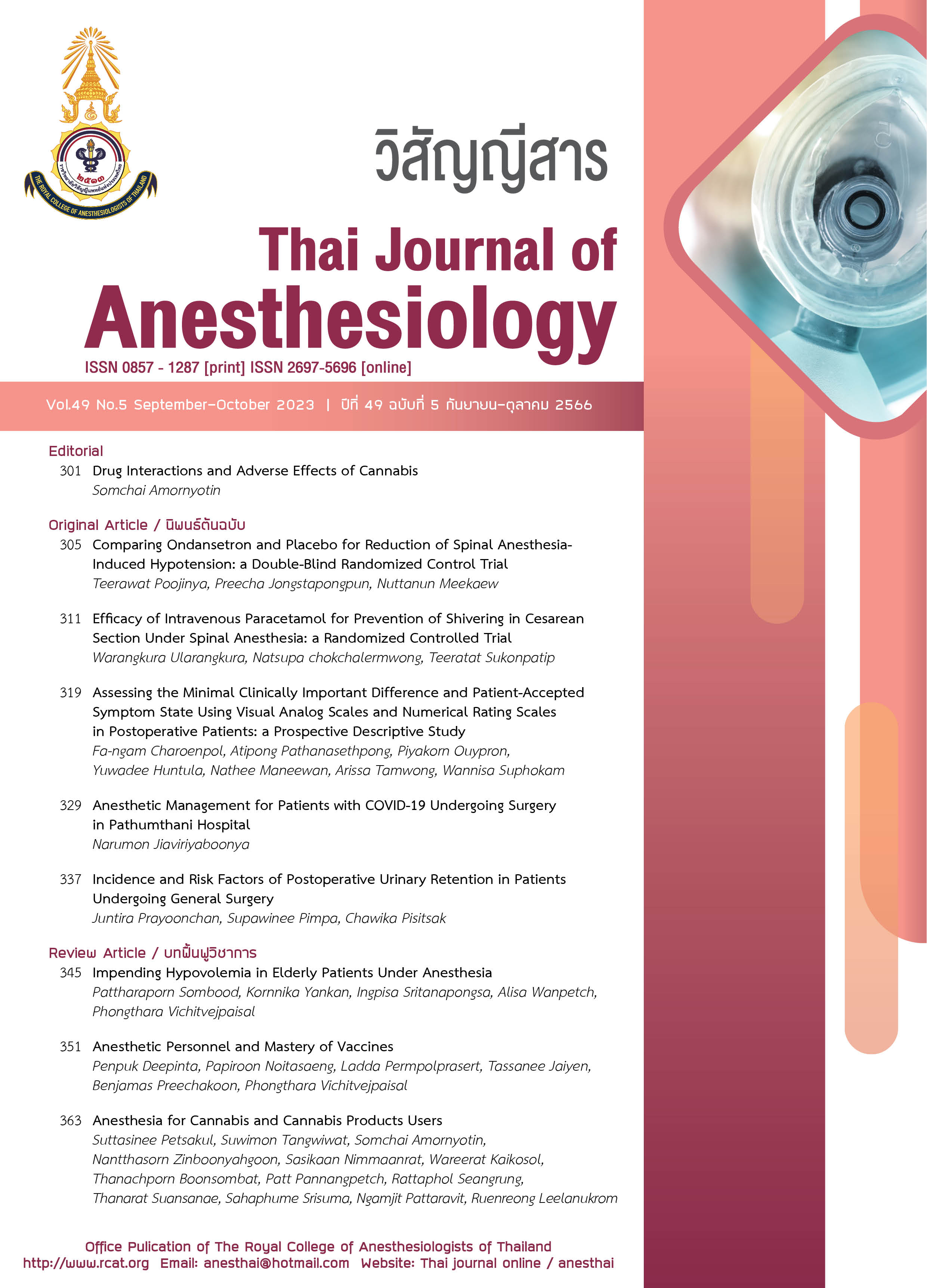Assessing the Minimal Clinically Important Difference and Patient-Accepted Symptom State Using Visual Analog Scales and Numerical Rating Scales in Postoperative Patients: a Prospective Descriptive Study
Main Article Content
Abstract
Introduction: Visual analog scale (VAS) and numerical rating scale (NRS) are widely used in measuring pain scores and guide treatment. In using these tools, the minimal clinically important difference (MCID) and patient acceptable symptom state (PASS) are crucial for guiding treatment. However, they vary in different situations and populations. The aim of the present study was to determine MCID and PASS for acute pain in elective surgical patients. Materials and methods: Pain assessment was done by first measuring VAS and NRS in the immediate postoperative period. Then 24 hours later, participants were asked to rate their pain score, perception of pain change, and state of recovery. The mean changes in pain scores among patients who reported “a little change” were used to calculate MCID. The 75th percentile of pain score rated by participants who considered themselves as having recovered well from surgery was defined as PASS. Results: Data from 79 of 104 participants, after excluding illogical data, showed that the MCID was 16 mm for VAS and 1.8 for NRS. While PASS for VAS and NRS were 38 mm and 5, respectively. Conclusion: MCID and PASS in our setting were similar to other population.
Article Details

This work is licensed under a Creative Commons Attribution-NonCommercial-NoDerivatives 4.0 International License.
References
Gan TJ. Poorly controlled postoperative pain: prevalence, consequences, and prevention. J Pain Res. 2017;10:2287-98.
Campbell WI, Patterson CC. Quantifying meaningful changes in pain. Anaesthesia. 1998;53:121-5.
Myles PS, Urquhart N. The linearity of the visual analogue scale in patients with severe acute pain. Anaesth Intensive Care Med. 2005;33:54-8.
Bodian CA, Freedman G, Hossain S, Eisenkraft JB, Beilin Y. The visual analog scale for pain: clinical significance in postoperative patients. J Am Soc Anaesth. 2001;95:1356-61.
Peters ML, Patijn J, Lamé I. Pain assessment in younger and older pain patients: psychometric properties and patient preference of five commonly used measures of pain intensity. Pain Med. 2007;8:601-10.
Ferreira-Valente MA, Pais-Ribeiro JL, Jensen MP. Validity of four pain intensity rating scales. Pain. 2011;152:2399-404.
Emshoff R, Bertram S, Emshoff I. Clinically important difference thresholds of the visual analog scale: a conceptual model for identifying meaningful intraindividual changes for pain intensity. Pain. 2011;152:2277-82.
Kvien TK, Heiberg T, Hagen KB. Minimal clinically important improvement/difference (MCII/MCID) and patient acceptable symptom state (PASS): what do these concepts mean? Ann Rheum Dis. 2007;66(Suppl 3):iii40-1.
Tubach F, Ravaud P, Martin-Mola E, et al. Minimum clinically important improvement and patient acceptable symptom state in pain and function in rheumatoid arthritis, ankylosing spondylitis, chronic back pain, hand osteoarthritis, and hip and knee osteoarthritis: results from a prospective multinational study. Arthritis Care Res. 2012;64:1699-707.
Myles PS, Myles DB, Galagher W, et al. Measuring acute postoperative pain using the visual analog scale: the minimal clinically important difference and patient acceptable symptom state. Br J Anaesth. 2017;118:424-9.
Hsieh AY, Tripp DA, Ji LJ, Sullivan MJL. Comparisons of catastrophizing, pain attitudes, and cold-pressor pain experience between Chinese and European Canadian young adults. J Pain. 2010;11:1187-94.
Campbell CM, Edwards RR. Ethnic differences in pain and pain management. Pain Manag. 2012;2:219-30.
Rahim-Williams B, Riley JL III, Williams AKK, Fillingim RB. A quantitative review of ethnic group differences in experimental pain response: do biology, psychology, and culture matter? Pain Med. 2012;13:522-40.
Ruangrit T, Sindhvananda W. Pain perspectives in Thai chronic pain patients. Thai J Anesthesiol. 2018;44:127-35.
Forgeron PA, Jongudomkarn D, Evans J, et al. Children’s pain assessment in Northeastern Thailand: perspectives of health professionals. Qual Health Res. 2009;19:71-81.
Bernstein DN, Mayo K, Baumhauer JF, Dasilva C, Fear K, Houck JR. Do patient sociodemographic factors impact the PROMIS scores meeting the patient-acceptable symptom state at the initial point of care in orthopaedic foot and ankle patients? Clin Orthop. 2019;477:2555-65.
Bahreini M, Safaie A, Mirfazaelian H, Jalili M. How much change in pain score does really matter to patients? Am J Emerg Med. 2020;38:1641-6.
Chen CX, Kroenke K, Stump TE, et al. Estimating minimally important differences for the PROMIS pain interference scales: results from 3 randomized clinical trials. PAIN. 2018;159:775.
Olsen MF, Bjerre E, Hansen MD, et al. Pain relief that matters to patients: systematic review of empirical studies assessing the minimum clinically important difference in acute pain. BMC Med. 2017;15:35.
Ousmen A, Touraine C, Deliu N, et al. Distribution- and anchor-based methods to determine the minimally important difference on patient-reported outcome questionnaires in oncology: a structured review. Health Qual Life Outcomes. 2018;16:228.
Chow SC, Shao J, Wang H, Lokhnygina Y. Sample size calculations in clinical research. CRC press. 2017;p51.
Kelly AM. Does the clinically significant difference in visual analog scale pain scores vary with gender, age, or cause of pain? Acad Emerg Med. 1998;5:1086-90.
Rhee WJ, Chung CJ, Lim YH, Lee KH, Lee SC. Factors in patient dissatisfaction and refusal regarding spinal anesthesia. Korean J Anesthesiol. 2010;59:260-4.
Bhattarai B, Rahman TR, Sah BP, Singh SN. Central neural blocks: a quality assessment of anaesthesia in gynaecological surgeries. Nepal Med Coll J. 2005;7:93-6.


